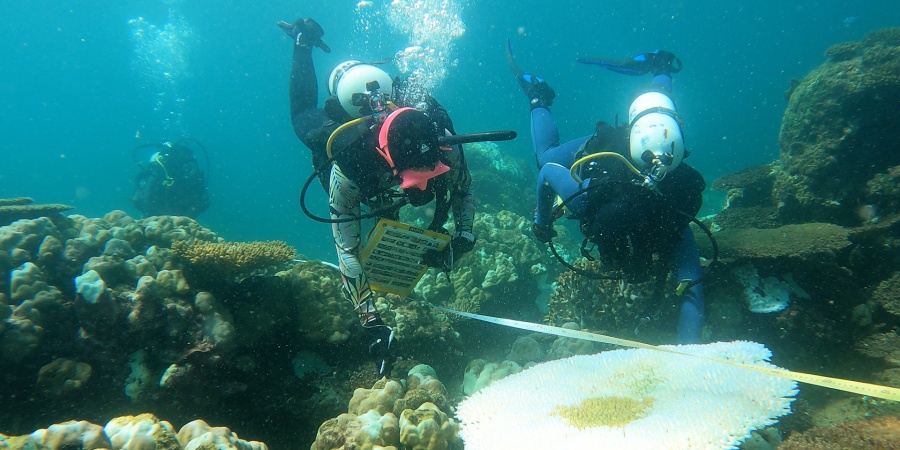
In-water surveys of coral and invertebrates at Black Rock, Montebello Islands Marine Park. Photo - DBCA
High levels of coral bleaching and mortality have been observed across thousands of kilometres of reef systems along the north-west atolls, Kimberley, Pilbara and northern-Gascoyne coasts, almost 12 months after a marine heatwave caused record breaking seawater temperatures.
The Department of Biodiversity, Conservation and Attractions (DBCA) and external collaborators have been undertaking monitoring using in-water surveys, underwater drones, aerial flights, and in-water temperature loggers.
Latest findings include:
- greater than 60 per cent bleaching across more than half of reef sites observed through aerial surveys of the wider inshore Kimberley region, including multiple marine parks
- very high levels of coral mortality due to bleaching and heat stress at shallow sites surveyed at the Dampier Archipelago
- 60 per cent decline in coral cover and continued bleaching of remaining live corals at long-term monitoring sites in the Montebello and Barrow Islands Marine Conservation Reserves since previous surveys conducted in 2022
high levels of bleaching and mortality at sites in Ningaloo Marine Park, with aerial surveys confirming bleaching along the full length of Ningaloo Reef and across reefs in the Exmouth Gulf region. - Monitoring in other ecosystems, including seagrass meadows is also occurring to better understand how the event is impacting Western Australia’s unique marine environment.
DBCA Research Scientist Dr Claire Ross said sensitive reef-building corals are often the first to bleach and die under heat stress, but other taxa including macro-invertebrates, fish, seagrass and algae are also being monitored to understand the broader ecosystem impacts.
“DBCA has a well-established, long-term monitoring program of a range of marine ecosystems within marine parks, including coral reefs, giving us important insights into the health of these areas and the ability to detect the impacts of and recovery from marine heatwaves,” Dr Ross said.
DBCA has also been engaging closely with regional communities and stakeholders, such as tourism operators.
Dr Ross said data and imagery collected from the ongoing surveys is still being analysed, and the full impacts of the marine heatwave might not be known for some time.
“Where possible, further surveys of coral and other marine communities across impacted areas will continue throughout 2025 and into 2026 to determine the full impact of this event,” Dr Ross said.
DBCA, in collaboration with the Australian Institute of Marine Science, is hosting a public talk and panel discussion on the marine heatwave during National Science Week at 6:30pm on Tuesday 12 August at the Indian Ocean Marine Research Centre in Crawley. For more information and to register for a free ticket, visit trybooking.com/DEHKT